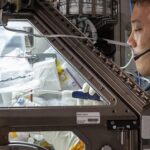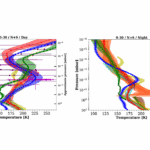Now Reading: Sceye wins NASA award for stratospheric Earth observations
-
01
Sceye wins NASA award for stratospheric Earth observations
Sceye wins NASA award for stratospheric Earth observations


WASHINGTON — A company developing stratospheric platforms for telecommunications and related applications has won a NASA award to use that platform for environmental monitoring.
New Mexico-based Sceye announced Nov. 6 that it, along with remote sensing company Spectral Sciences, Inc., received a Phase 2 Small Business Innovation Research (SBIR) award from NASA to demonstrate an environmental sensor that can provide persistent monitoring from the stratosphere.
The $850,000 award funds work on a hyperspectral sensor by Spectral Sciences that would be flown on Sceye’s high-altitude platform system (HAPS) in late 2026 or early 2027. The HAPS would operate in stratosphere for weeks to months for a variety of Earth observation applications.
“Access to continuous, high-quality data from the stratosphere will transform how we understand and safeguard our environment,” said Marsha Fox, vice president of operations and chief scientist at Spectral Sciences, in a statement.
“With earlier warnings and more precise monitoring of crops, natural resources, vegetation cycles, volcanic plume events, and ephemeral phenomena, we can take targeted actions that benefit communities, ecosystems, and economies alike,” she said.
Sceye has been working for several years on its HAPS vehicle, a lighter-than-air system with an aerodynamic form factor that is able to loiter over regions for extended periods, using solar power in daytime and batteries at night. The company’s focus has initially been on communications but it sees this award as a way of demonstrating how it can serve Earth observation markets.
“What this will ideally enable is this actual continuous and persistent observation from the stratosphere, which is something that we’re completely lacking,” said Mikkel Vestergaard Frandsen, chief executive and founder of Sceye, in an interview.
The Sceye platform, he said, can provide extended, continuous monitoring that satellites or drones cannot. “In contrast to drones, we stay up and, in contrast to low Earth orbit satellites, we stay over the same area.”
He added, though, that he did not see the company’s HAPS platform as competing directly with satellites in Earth monitoring. Satellites, he noted, can provide a global perspective for things like detecting methane leaks, while a stratospheric platform can provide more precise and persistent data.
“We can see the rate of emission. We can see where the plume is going. We can provide operational input” to the organization working to eliminate the leak, he said.
The big driver for the Sceye HAPS platform, though, has been telecommunications. “The race to the stratosphere is really driven by and fueled by multinational telecom corporations who want to offer services such as instant infrastructure after a tsunami or hurricane or an earthquake,” he said, or to serve rural markets.
The companies, he said, “see the stratosphere as a natural link between towers and space as one ubiquitous network.” In that scenario, he said HAPS could serve regions that lack the population density for terrestrial networks but may have too much demand for satellite services.
Among the companies working with Sceye is SoftBank, which made an investment of undisclosed size Sceye announced in June that is intended to be the first tranche of a Series C round. The funding agreement includes a purchase by SoftBank of a “pre-commercial” flight of Sceye’s vehicle in Japan in 2026.
The company has been gradually building up the performance of the HAPS platform, focusing first on the details needed for getting to stratospheric altitude and now testing the vehicle’s performance there, Frandsen said. “This year is all about endurance: staying up to see what fails first, generating a baseline, essentially, from where we’ll gradually improve from weeks to months to a year.”
That will be followed by commercial pilot flights in Japan and elsewhere in 2026 focused on providing communications services. Commercial operations would follow “immediately thereafter,” he said.
Besides communications and Earth observation, Sceye is examining other applications for the HAPS platform. That includes edge computing to support drone operations as well as quantum key distribution.
Stay Informed With the Latest & Most Important News
Previous Post
Next Post
-
 01From Polymerization-Enabled Folding and Assembly to Chemical Evolution: Key Processes for Emergence of Functional Polymers in the Origin of Life
01From Polymerization-Enabled Folding and Assembly to Chemical Evolution: Key Processes for Emergence of Functional Polymers in the Origin of Life -
 02Panasonic Leica Summilux DG 15mm f/1.7 ASPH review
02Panasonic Leica Summilux DG 15mm f/1.7 ASPH review -
 03How New NASA, India Earth Satellite NISAR Will See Earth
03How New NASA, India Earth Satellite NISAR Will See Earth -
 04And Thus Begins A New Year For Life On Earth
04And Thus Begins A New Year For Life On Earth -
 05Astronomy Activation Ambassadors: A New Era
05Astronomy Activation Ambassadors: A New Era -
 06Two Black Holes Observed Circling Each Other for the First Time
06Two Black Holes Observed Circling Each Other for the First Time -
07SpaceX launch surge helps set new global launch record in 2024



















